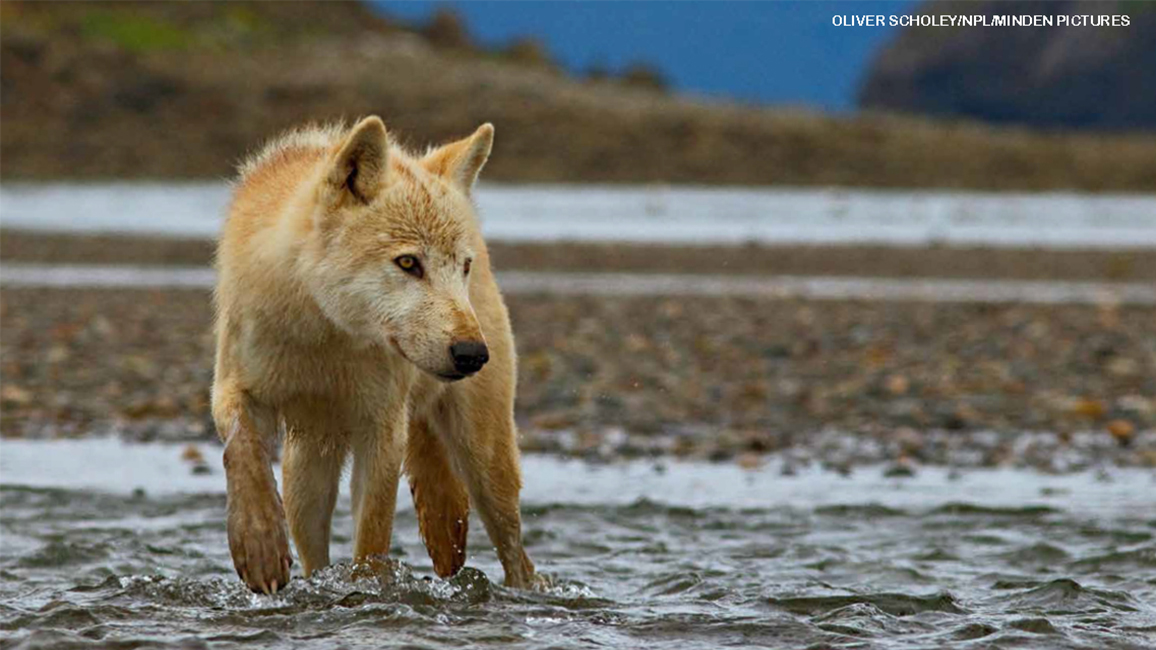
Sea Wolves
By Anne CisselThis special wolf hunts in the surf and on the shore—and even swims in the ocean!
On a windswept coast, seals and sea lions sunbathe as gulls fly overhead. Out in the ocean, whales surface to breathe. And prowling on the beach, there’s another, more unexpected ocean adventurer: a wolf.
This wolf (above) is a type of gray wolf known as a sea wolf. Sea wolves live along the coast of western Canada and Alaska, and on the hundreds of islands nearby. But they don’t always stay on dry land. They dive into the cold northern Pacific Ocean and swim between islands, searching for food.
Wolves . . . in the ocean? This may be surprising to you. But people living here have known about them for thousands of years. In Canada, these groups of people, known as First Nations, protect the land and sea that the wolves need to survive. Let’s dive in and learn more about these mysterious wolves—and how people are trying to help them.

Seafood Menu
If you close your eyes and think of wolves, what do you see? Maybe a pack of them running through the forest, chasing a deer? Sea wolves are different. In addition to the nearby forest, the beach is their hunting ground. The wolves that live closest to the ocean feast mostly on seafood.
Salmon is a favorite sea-wolf meal. The wolves are picky eaters, though. Most of the time, they eat only the heads of the salmon they catch. Salmon bodies can carry germs that could make the wolves very sick, so they avoid eating the whole fish. When scientists find a headless salmon, that’s a clue that a sea wolf has been nearby.

Sea wolves also hunt other ocean life, such as seals and sea otters. They eat shellfish by cracking open the shells with their strong jaws.
They dine on fish eggs they find on sea grass. Even a beached whale or squid makes a fine meal. The wolves know the best times to patrol the shoreline: just after the tide has gone out, when tasty snacks may have been left behind.
Sea wolves act the same as other wolves in some ways. They live in packs and will hunt deer, especially the wolves that live farther inland. They communicate with each other using scents, sounds, and body language. But sea wolves spend a lot more time in the water than other types of wolves. They are fast, powerful swimmers. To move between islands, they will paddle for miles with just their ears, eyes, and noses poking up above the surface.

Scat Tracking
Scientists often study other gray wolves by capturing them and attaching tracking tags to them. Hair or blood samples might be taken to learn more about the animals. But sea wolves are studied differently because most of them live on First Nations land. Because they are so special to these people, the wolves are disturbed as little as possible. But that doesn’t mean they can’t be studied. Instead of tagging them, scientists collect the wolves’ poop, or scat.
By studying the scat, scientists can tell what the wolves have eaten and whether they are healthy. They can also learn a lot from looking at the DNA in the scat. (DNA is a microscopic set of instructions in the cells of every living thing.) The sea wolves’ DNA tells scientists that the wolves are different from the gray wolves that live inland. They are a bit smaller than inland wolves, their fur is usually darker, and their skulls and teeth are shaped a bit differently.

Protecting the Wolves
The coastal First Nations, working with the government and wildlife groups, have protected much of the land the sea wolves live on. But the wolves are still threatened. Too much logging—taking trees down for building and other uses—hurts the wolves’ habitat. And hunting wolves is still legal in most parts of Canada and Alaska. So, First Nations and others continue to work to keep these beautiful creatures—and all wildlife along the coast—safe.

















